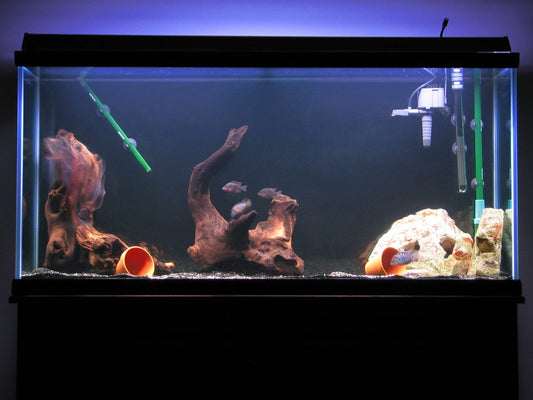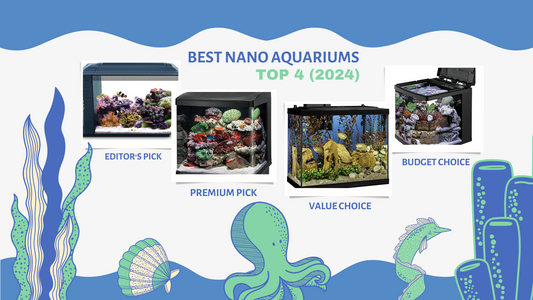How To Quarantine Fish in 2024

Buying new fish is not always a simple affair. They may have internal parasites and other diseases that need treatment. Sometimes the fish you already have may also develop a disorder that needs examination.
That’s where a quarantine tank is handy! These setups are like a hospital bed for stressed fish. You can do water changes, ensure new fish eat well, and use medications in smaller doses. So what is involved in setting up a quarantine aquarium for your fish, this beginners guide will cover it all!
Why Should You Quarantine Fish?
If you have the time and space for a quarantine tank it can save you and your pets a lot of frustration and stress. Assuming all of your pets are happy, how do they suddenly contract ich and other parasites?
New fish are the main source of diseases that come into your main display tank. Most people don’t quarantine fish from the pet store. Some even pour pet store water into their tank setup; a sure way to get a dose of germs and pathogens to your fish.
Keeping new fish in a quarantine tank allows you to monitor them for a short period. If they suddenly become sick, they are isolated from your main tank.
Treatment for sick fish is also a lot less complicated in a quarantine tank. You can use medication that would stress or kill sensitive animals in your main tank. The sick fish may also be slowed by the disease. By keeping it in quarantine, it does not have to compete with healthy ones for food.
Setting Up A Quarantine Tank
A quarantine tank does not have to be a complicated or pretty setup. In fact, you don’t want it to be. The tank should be easy to clean, with a bare bottom. Bare tanks mean you can quickly remove fish poop and leftover food.
A filter that is effective yet quick to maintain is also crucial. I recommend using a sponge filter but power or canister filters can also work.
Aquarium lights should be basic but not too strong. Fish will feel exposed in a quarantine tank with little decorations. If the light has power adjustments, that’s even better. That way, you can brighten them for examining a sick fish.
And then dim the lights again so it won’t be stressed. As far as decorations, some plastic plants and maybe a cave for more secretive species are all you need!
Supplies Needed
Here are the supplies I use to setup quarantine tanks:
Check Price on Amazon
Aqueon Standard Glass Aquarium 10 Gallon Aqueon Aquarium Water Conditioner Bottle hygger Aquarium Double Sponge Filter Tetra Whisper Air Pump hygger Full Spectrum LED Light Marineland Silk Plants Multi-Pack MICROBE-LIFT Nite-Out II Cleaner Aquarium Salt FREESEA 50 Watt Tank HeaterQuarantine Tank Layout and Setup
Step 1: Fill your aquarium with water. Use conditioner to remove chlorine and chloramine from tap water. These chemicals are toxic to fish and other aquatic life if not removed.
Step 2: Add the heater and allow the water temperature to reach the ideal range for the fish that’s being quarantined. Aim for the higher end of the spectrum if you can. Warmer temperatures increase the metabolism of fish, aiding in their ability to fight diseases.
Many pathogens also go through their life cycle faster. This helps with the quarantine process because medications don’t always work on every life stage of parasites.
Aquarium fish ich, for example, isn’t vulnerable when it is a visible white cyst on the skin of your fish. It is the free swimming parasites that medication targets.
Step 3: Add your sponge filter, placing it into a convenient corner. The filter should be connected to the air pump. The sponge filter will provide gentle circulation and oxygenation as well.
Step 4: Add a light dose of aquarium salt to the quarantine tank. One tablespoon per 3 to 5 gallons is an effective medicinal dose. You can use more if the new fish are salt lover, such as mollies and other livebearers. African cichlids also thrive with aquarium salt doses. But use less if you have tetra fish, cory catfish, betta fish, and other soft water species. They are sensitive to salt and will be stressed if you use too much. Salt baths are preferable for tetra disease treatment.
Step 5: Add a dose of aquarium nitrifying bacteria to the water. Unless your quarantine tank is always running, it won’t have time to cycle before you add your sick fish. A cycled tank is one that can handle ammonia, nitrite, and nitrate. But the process normally takes around 4 weeks to complete. Fortunately, bottled bacteria do an excellent job at quick-cycling your aquarium!
Step 6: Check the water parameters using your freshwater aquarium test kit.
Assuming they are close to the conditions of the pet store and your main tank, add your quarantine fish to the new aquarium! Also add any decorations, like fake plants, driftwood, rocks, or caves at this stage.
Step 7: Monitor your new fish. Feed sparingly and take notes on its progress.
Step 8: Over time continue with your water quality tests. Perform water changes as needed. I recommend small, frequent water changes over infrequent larger ones. Smaller changes will keep the water parameters stable. And prevent spikes of ammonia, which make things harder for fish immune systems.

Observing Fish In Quarantine Tanks
An important part of quarantining new fish is the observe it daily. What are some of the issues you should be on the look out for?
- Skin, Fins, Eyes, and other External Factors: we want the tank to have few decorations not just to ease cleaning. A bare tank ensures we get a good look at our quarantine fish. Observe its skin first. Do you see patches of mucus or open wounds? Are fins frayed and clamped? Fish colors may stay dull but are they discolored in dangerous ways? Are the eyes clear or cloudy? Do you see signs of ich, fungus, or other external parasites? Is the poop solid or pale and stringy? These and other signs of stress in aquarium fish will tell you when its time to bring it over to your main display tank!
- Feeding Response: a new fish probably won’t eat the first day as moving to a quarantine tank causes stress. Its immune system may also be fighting illnesses, affecting its hunger level. Feed sparingly but do so two or three times per day. Try offering a treat like live or frozen food. We really want a fish in quarantine to be eating well. So if it refuses flakes once, don’t try and force it to eat them a second or third time. Wild caught fish should always be given fresh food in quarantine.
- General Behavior: the look of your fish is important but its behavior will also give you insides into diseases and its system health. Do schooling fish hang together or swim listlessly around, ignoring each other? Does the fish respond when you come near the quarantine tank or does it seem to not see you?
- Disease Progression: last, we want to monitor the signs of diseases that we are sure about. Has the number of white spots from ich increased or decreased? How about fungal patches, infections from bacteria, and so on? Do you need to add a second dose of medication?

How Long Should You Quarantine New Fish?
The length of the quarantine period depends on the reason for observation. As well as what issues arise, if any. What if you’re doing a general quarantine for a new freshwater or marine fish that is not showing any problem signs?
4 to 7 days is enough time before moving it to your established tank. As long as it is eating and behaving normally, it will be a safe addition!
Fish that are known to be sick should be kept in quarantine for longer periods. Once a disease has progressed, wait 2 to 3 more days to ensure it is cured for good.
2 weeks is a normal quarantine period for sick pets. Once the fish shows no signs of disease and is eating properly, then move it to your main aquarium.
Additional Tips for Treating Fish in Quarantine
Follow any medication dosing instructions with care. Scaleless fish like loaches or catfish may need a 1/2 dose rather than a full dose. Tetras should also be given a smaller dose of medication at first.
It’s also important not to use filters with activated carbon on a quarantine tank. Carbon will remove most medications from the system, aquarium salt not included.
You don’t need to be as concerned with the usual stocking limits in a quarantine tank. A new or sick fish won’t be living there for very long. Even a fairly large (4 to 8 inches) new fish can be quarantined in a 10 or 20 gallon tank until it’s ready to move.
Conclusion
Sometimes a new fish might have ich that will spread to your other fish. Or it has internal parasites that will be fatal if not medicated. Maybe you have fish that has wounds inflicted by an aggressive tank mate. No matter the cause, a small quarantine tank is helpful to have in storage.
It takes just a few minutes to set one up. They ensure you can target-treat a fish with medications. Sick and slow-moving fish also don’t have to compete with others for food. Ensuring you can nurse them back to health as fast as possible!
No comments







comments